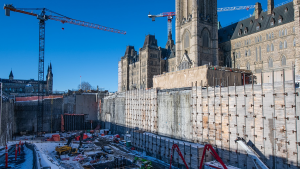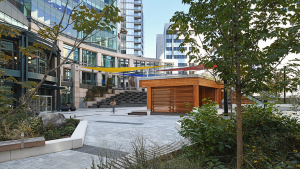Structural steel reuse is currently pretty rare in projects in şÚÁĎłÔąĎÍř, but the Centre Block rehabilitation on Parliament Hill in Ottawa is an example of a massive project with a sustainable focus.
In her presentation, Practical Considerations for the Reuse of Structural Steel at the Canadian Institute of Steel Construction conference in Toronto, structural engineer Isis Bennet, CENTRUS Joint Venture at WSP şÚÁĎłÔąĎÍř Inc., used the project as a case study.
“In the upper levels there is some steel that needs to be removed in order to facilitate this rehabilitation,” said Bennet.
“This steel that is being removed is what we’ve identified as a big opportunity to take the steel out where it needs to be demolished and bring it back to this exact same project in the new construction phase.”
The reason for doing it, she said, is embodied carbon.
“We have about 625 tonnes of CO2 equivalents, so that’s embodied carbon that’s being retained on the project,” said Bennet. “For the material that can’t be reused in the Centre Block project we’ve identified some of that for reuse on future projects. Of course some needs to be sent to recycling.
“The members that are being removed from the building and brought back, we’ve identified 1,700 that we will be reusing on this project.”
Before the team started the reuse initiative, they looked at the condition of the existing building.
“We needed some verification that the steel is in good condition, that the steel that we are finding on site matches the historic drawings, so we have confidence in the design and extending the life,” said Bennet.
“We need to test the steel to figure out what properties we should use when we’re designing. For the steel samples that were taken, we ended up deciding that we were going to design to 210 MPA.”
The team is doing a pre-selection process to identify members that have a high potential for reuse.
“If they’re too shallow they’re going to have a lower capacity, less potential for reuse,” Bennet explained. “We’re excluding members that are in built up sections. You don’t want somebody to have to go in and assess whether or not the rivets along the length of the built up member are in good condition. It’s not a good use of our resources. We’ve created this subset. We’re identifying that on our demolition drawings so they can know what members to be careful with and which ones not to be.”
Once they know what members have met that criteria, inventory will be delivered to the design team and they will decide what goes in Centre Block and what goes into storage.
The project is currently in the deconstruction phase.
“We’ve already released our specs, how to work with this steel, how it should be inspected and we’re starting demolition,” Bennet explained. “Each member is going to have a bar code. We’re going to be able to track that from it being removed from the building into the new construction phase where it’s installed.”
They have also identified some very simple dismantling methodology.
“Keep the members in one piece, cut it as close to the ends as possible, 50 millimetres from the supports and then we’re removing all the connectors along the length so we have a nice smooth beam,” said Bennet.
“We are adding some storage requirements because we want these members to be protected from the elements. We don’t want them to degrade while were waiting for this to be built. We’ve also informed the fabricator that this is what we’re doing. We’re telling them the steel is 210 MPA and they need to design connections accordingly.”
Once all the beams have passed inspection, they are then passed to the design team which will try to keep it as simple as possible, Bennet said.
“We’re designing the beam the way we normally would,” she noted. “We have a new beam that has been designed, the target beam, and then we are looking for matches between salvaged steel inventory and these target beams, so where can we substitute this in? A pretty simple way to do that is just cross reference the capacities. Is the salvaged beam equal to or greater in capacity to the target beam?”
She admits that might raise a few eyebrows because the salvaged beam has a lower strength.
“Is this beam going to be a little bigger? Potentially, yes,” she said. “We’re going to have deeper sections in a lot of locations, so we need to consider this in the design and identify what beams have a depth limit.”
She pointed out although there are costs associated with reusing members, the cost of new steel also exists, so the cost to offset substituting reused steel for new steel actually pays for itself and becomes cost neutral.
Going forward she said it’s important to make it easier for designers to reuse steel on projects.
“From my perspective, I see an industry that needs a supplier, so I can order reused steel the same way I do new steel,” she said, adding standardization is also needed.
“It’s important to figure this out to spur more steel reuse.”
Follow the author on Twitter .







Recent Comments
comments for this post are closed